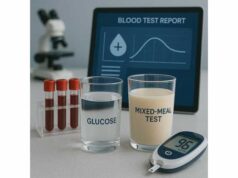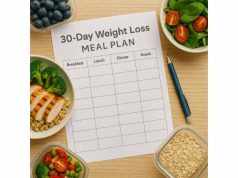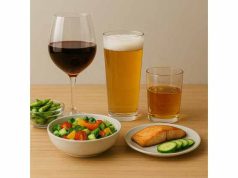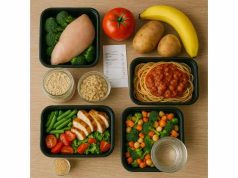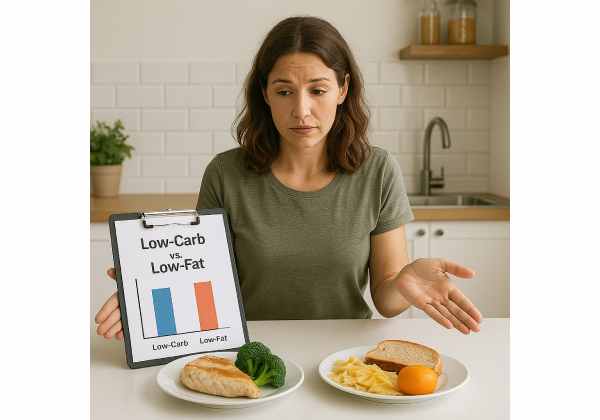
Choosing between low-carb and low-fat is not about joining a team—it is about picking the eating pattern you can follow most days without white-knuckle effort. Both keep calories in check when they are planned well. What differs is how they manage hunger, energy, and food choices. In this guide, you will learn how each approach works, who tends to do better with which, and how to build plates that fit your lifestyle. If you still need to set your calorie target and big-picture structure, start with our overview of calorie and macro planning, then come back to decide where your daily carbs and fats should land.
Table of Contents
- Low-carb vs low-fat: the basics
- How to choose your diet
- What to eat on each plan
- Mistakes and troubleshooting
- Safety and who should avoid
- What does the evidence say
- Two-week experiment plan
- Frequently Asked Questions
Low-carb vs low-fat: the basics
What “low-carb” means
Low-carb diets restrict carbohydrate-dense foods—grains, sugars, and large portions of starchy vegetables—to shift calories toward protein and fat. A practical range is 50–150 g carbs/day for most people, with ketogenic plans dropping under 50 g. Protein stays moderate-to-high to protect lean mass, and non-starchy vegetables provide fiber and volume.
What “low-fat” means
Low-fat plans limit added oils, high-fat dairy, fattier cuts of meat, nuts, and baked goods. Fat typically sits near 20–30% of total calories, sometimes lower in structured programs. Carbohydrates—ideally high-fiber sources like whole grains, beans, fruit, and starchy vegetables—make up the difference, with protein kept adequate.
What actually causes fat loss
No matter the split, a consistent calorie deficit drives weight loss. Macros (carbs, fat, protein) change how easy that deficit feels: protein and fiber support fullness; carb timing influences workout performance; fat adds satisfaction but is energy-dense. The right pattern is the one that helps you eat fewer calories without constant hunger.
How each approach feels in real life
- Low-carb often blunts appetite for some people, especially when protein is high and meals have satisfying textures (eggs, fish, tofu, avocado, olive-oil dressings in measured amounts). Early scale drops can include water weight as glycogen stores shrink.
- Low-fat lets you eat larger plates for the same calories by leaning into high-volume, low-calorie foods—soups, fruits, legumes, whole grains, and big vegetable servings. Many find this approach easier in social settings and less restrictive at restaurants.
Performance and daily energy
If you train hard (lifting, running, cycling), timing carbs around workouts often helps—regardless of diet. On low-carb, you may cluster carbs pre/post training; on low-fat, carbs are more evenly spread.
When each fits best—quick snapshot
- Low-carb suits those who love savory meals, prefer protein-forward plates, and do not mind limiting bread, sweets, and large grain portions.
- Low-fat suits those who want bigger bowls and fruit/legume/grain variety, and who find it easy to measure oils and richer add-ons.
If you still need a refresher on safe pacing and expectations before you choose, skim our checklist on safe weight-loss basics.
How to choose your diet
Use this decision framework to pick a starting lane you can actually follow. You can always switch after a short, structured trial.
1) Inventory your preferences
- Which foods make you feel satisfied? Eggs, fish, yogurt, tofu, and vegetables point toward low-carb; soups, rice, beans, fruit, and big salads point toward low-fat.
- Which foods trigger overeating? If nuts and oils lead to “portion blur,” low-fat might fit better. If bread and sweets get mindless, low-carb can reduce friction.
2) Map to training and work
- Heavy training weeks: ensure carbs around workouts, even on a low-carb plan.
- Sedentary days or focus-heavy work: some feel steadier with higher protein and vegetables (low-carb) while others need frequent carb-inclusive meals (low-fat). Test, do not guess.
3) Check your cooking style and budget
- Minimal cooking: choose an approach that uses more ready-to-eat staples (rotisserie chicken, canned fish, frozen vegetables, pre-cooked grains, plain yogurt).
- Tight budget: both work. Low-fat leans on bulk grains and beans; low-carb leans on eggs, canned fish, tofu, chicken thighs, and low-cost produce.
4) Pick a starting macro shape
- Low-carb start: Protein 1.6–2.2 g/kg goal weight, carbs 50–150 g/day, fat fills the rest (often 35–55% of calories).
- Low-fat start: Protein 1.6–2.2 g/kg, fat 20–30% of calories (do not drop below 0.6–0.8 g/kg), carbs fill the rest.
Need a primer on setting macros step-by-step? Open our quick guide to macro ratios and plug your numbers into the templates below.
5) Decide how you will measure
- Trackers: Weigh oils, grains, and snacks for 1–2 weeks, then shift to visuals.
- Hand portions: palm protein, cupped-hand carbs, thumb fats, two fists vegetables.
- Meal templates: repeat 3–5 easy combinations you enjoy.
6) Set your review window
Commit to 14 days before changing course. Judge by hunger, energy, workout quality, adherence, and the two-week average of your morning weigh-ins—never by a single day.
What to eat on each plan
You do not need gourmet recipes. Build repeatable plates with a protein anchor, vegetables for volume, measured fats, and smart carbs where they fit.
Proteins to keep on hand (mix and match)
Chicken breast or thighs, turkey, lean beef, pork tenderloin, fish (salmon, cod, tuna, sardines), eggs, tofu, tempeh, skyr or Greek yogurt, cottage cheese. For a concise reference with portions, see our list of high-protein foods.
Low-carb plate builder
- Protein (30–40 g): eggs, fish, chicken, tofu/tempeh.
- Non-starchy veg (2–3 cups): leafy greens, broccoli, cauliflower, zucchini, peppers, mushrooms.
- Carb window (10–30 g): berries, beans/lentils (small portions), or measured rice/potatoes near workouts.
- Fats (measured): olive oil (1–2 tsp), avocado (¼–½), nuts/seeds (10–20 g), olives.
Low-fat plate builder
- Protein (25–40 g): lean meats, tofu/tempeh, nonfat/low-fat dairy, eggs with extra whites.
- High-volume carbs: potatoes, sweet potatoes, beans/lentils, brown rice, whole-wheat pasta, oats, corn tortillas, fruit.
- Vegetables: 2 cups or more per meal.
- Fats (light): 1 tsp oil or a small sprinkle of nuts/cheese as flavor, not the base.
Sample day — low-carb (≈1,900–2,100 kcal as a framework)
- Breakfast: 3-egg scramble with spinach, mushrooms, and feta; ½ avocado.
- Lunch: grilled chicken salad with mixed greens, tomatoes, cucumbers, olives, and a measured 1 tbsp vinaigrette.
- Snack: skyr or Greek yogurt with ½ cup berries.
- Dinner: salmon with roasted broccoli and cauliflower; small roasted potato if training day.
- Optional: 1 square dark chocolate or herbal tea.
Sample day — low-fat (≈1,900–2,100 kcal)
- Breakfast: skyr with oats, berries, and cinnamon.
- Lunch: rice and bean bowl with salsa, roasted peppers/onions, shredded chicken or tofu, big side salad.
- Snack: cottage cheese with pineapple or cucumber.
- Dinner: baked potato with chili (extra beans), steamed greens; 1 tsp olive oil or yogurt dollop.
- Optional: fruit or broth-based soup if hungry.
Snack ideas (100–250 calories)
- Low-carb lean: turkey slices with pickles; edamame; yogurt and berries.
- Low-fat lean: air-popped popcorn; fruit plus skyr; vegetable soup cup.
Restaurant swaps
- Low-carb: grilled protein + double vegetables; starch as a small side.
- Low-fat: grilled or roasted mains; request dressing/sauces on the side; pick baked or steamed starches.
Mistakes and troubleshooting
Even good plans fail if one or two habits drift. Use these common pitfalls and fixes to keep progress steady.
Low-carb slip-ups
- Forgetting vegetables and fiber: low-carb is not low-veg. Add 2 cups of non-starchy vegetables to most meals to control hunger.
- Nuts by the handful: great food, sneaky calories. Pre-portion 10–20 g.
- “Keto-ish” baked goods: often higher in calories than the original. Save for rare treats.
Low-fat slip-ups
- Oils and dressings without measuring: a “healthy drizzle” quickly adds 100–200 calories. Use teaspoons.
- Protein too low: low-fat is not low-protein. Keep 25–40 g per meal.
- Refined carbs crowd out produce: build plates around whole grains, beans, and vegetables, not pastries.
Both approaches
- Weekend drift: plan restaurant orders in advance; keep a “default dinner” at home (frozen vegetables + rotisserie chicken or tofu + sauce).
- Scale noise: average 3–4 weigh-ins per week and review the 14-day trend.
- Low energy training: move 15–30 g carbs to the meal before and after workouts.
If you want a broader checklist of roadblocks and fixes, skim our guide to common diet mistakes and pick one behavior to adjust this week.
Safety and who should avoid
General
Healthy adults can use either plan when calories, protein, vegetables, and micronutrients are covered. Most side effects (fatigue, headaches) reflect too few calories, dehydration, or low electrolytes, not the plan itself. Keep fluids and sodium appropriate—especially if you reduce carbs rapidly. For practical hydration cues and options, see our overview of hydration strategies.
Who should individualize with a clinician
- Diabetes or insulin resistance: both patterns can work; prioritize protein, vegetables, and measured starch portions. Monitor blood glucose with your care team if adjusting carbs substantially.
- Kidney disease: protein targets are individualized; do not raise protein without medical advice.
- Pregnancy or breastfeeding: weight loss is not usually recommended; focus on nourishment.
- Hyperlipidemia: if choosing low-carb, bias toward fish, olive oil, nuts/seeds; limit saturated fats.
- Gout: moderate purine-rich meats; emphasize fish, dairy, and plant proteins.
Vegetarian and vegan eaters
Both patterns are possible. Low-carb leans on tofu, tempeh, seitan (if tolerated), and low-carb vegetables with measured legumes; low-fat leans on beans, lentils, whole grains, vegetables, and fruit with low-fat soy or dairy alternatives for protein.
Warning signs to address quickly
Persistent dizziness, extreme fatigue, hair loss, menstrual irregularities, or significant mood changes. These suggest energy intake is too low or macro choices are imbalanced—pause the deficit and seek professional guidance.
What does the evidence say
Weight loss outcomes
Across months to a year, low-carb and low-fat produce similar average weight loss when calories and protein are matched and adherence is high. Early differences often reflect water shifts (carb glycogen changes) rather than body-fat changes.
Hunger and adherence
Satiety hinges more on protein and fiber than on carbs vs fats. People who keep protein near 1.6–2.2 g/kg goal weight and hit daily fiber targets report steadier hunger and fewer binges. If you routinely hit your protein but feel hungry, raise vegetable volume and add beans, lentils, or fruit in portions that match your plan. For practical numbers, check our guide to fiber targets.
Training and performance
Endurance and high-volume training typically feel better with more carbs, especially around workouts. Resistance training to maintain muscle is effective under both patterns when total protein and calories are appropriate.
Cardiometabolic markers
- Low-carb patterns often show larger short-term drops in triglycerides and increases in HDL.
- Low-fat, high-fiber patterns often reduce LDL more, particularly when saturated fat is kept moderate and whole grains and legumes are emphasized.
- Blood glucose control improves most with weight loss itself and regular activity; carb distribution and quality matter.
Bottom line
For most people, the “best” approach is whichever keeps you full, fueled, and consistent. Choose the pattern that makes weekday eating simple, not perfect.
Two-week experiment plan
You do not need a personality test to decide. Run a controlled experiment and let your data choose the winner.
Week 1: Low-carb trial
- Set calories (maintenance minus 300–500).
- Protein: 1.6–2.2 g/kg goal weight.
- Carbs: 75–125 g/day (cluster 25–50 g around training).
- Fats: fill the rest; measure oils and nuts.
- Meals: protein + 2–3 cups non-starchy veg + measured fats; fruit or small starch near workouts.
Week 2: Low-fat trial
- Same calories and protein as Week 1.
- Fat: 20–30% of calories (≥ 0.6–0.8 g/kg).
- Carbs: fill the rest with whole grains, beans, starchy veg, and fruit.
- Meals: protein + high-volume carbs + 2 cups vegetables; 1 tsp oil or light toppings.
Track the same signals both weeks
- Hunger (0–10) mid-afternoon and late evening.
- Energy during work and training.
- Adherence: number of meals that matched your plan.
- Average morning weight (at least 3 readings/week).
- Cravings and mood notes.
Choose and refine
- If hunger was lower and energy better on one approach, keep it.
- If both were similar, pick the style that was easier to live with (shopping, cooking, social meals).
- Keep protein steady. Tweak oils or starches by small amounts (1 tsp oil or ½ cupped hand carbs at dinner) and reassess after 14 days.
Frequently Asked Questions
Which loses weight faster: low-carb or low-fat?
Over months, results are similar when calories and protein match. Early low-carb drops often include water due to lower glycogen. Pick the plan you can follow most days with steady hunger and energy—consistency beats small macro differences.
How many carbs count as “low-carb”?
A practical, non-keto low-carb range is 50–150 g/day. Very low-carb or ketogenic plans drop under 50 g. Start higher if you train regularly, then adjust based on hunger, performance, and your two-week weight trend.
How low should fat go on a low-fat diet?
Keep fat at 20–30% of calories and avoid dropping below 0.6–0.8 g/kg of goal weight. This supports hormones, fat-soluble vitamins, and meal satisfaction. Trim oils and rich toppings first; do not cut protein to make room.
Can I build muscle on low-carb?
Yes—if calories, protein (1.6–2.2 g/kg), and training quality are in place. Many lifters cluster 25–50 g carbs around workouts on low-carb plans to support performance and recovery while keeping daily carbs modest.
Do I need to track every gram?
Not forever. Track for 1–2 weeks to calibrate portions, then use visuals: a palm of protein, cupped hand of carbs, thumb of fats, and two fists of vegetables per meal. If progress stalls for two weeks, track again briefly to recalibrate.
What if I plateau for two weeks?
Verify adherence, then make one small change: remove 1 tsp oil at two meals or reduce dinner carbs by ½ cupped hand. Keep protein and vegetables steady. Reassess after another 14 days instead of reacting to a single weigh-in.
References
- Low-carbohydrate versus balanced-carbohydrate diets for reducing weight and cardiovascular risk 2022 (Systematic Review)
- 5. Facilitating Positive Health Behaviors and Well-being to Improve Health Outcomes: Standards of Care in Diabetes—2024 2024 (Guideline)
- Systematic review and meta-analysis of protein intake to support resistance exercise in healthy adults 2022 (Systematic Review & Meta-analysis)
- A Heart-Healthy Diet for Cardiovascular Disease Prevention 2023 (Review)
Disclaimer
This article provides general nutrition guidance for adults and does not replace personalized medical advice, diagnosis, or treatment. If you have a medical condition, take prescription medications, are pregnant, or are breastfeeding, speak with your healthcare professional before making significant dietary changes.
Share and follow
If this comparison helped you choose a path, consider sharing it with someone starting a cut. For steady, practical nutrition ideas, follow us on whichever social network you use most.

